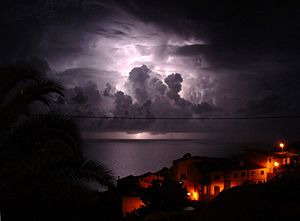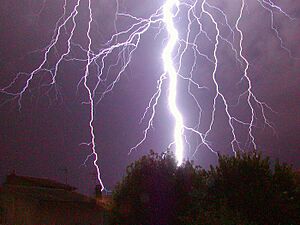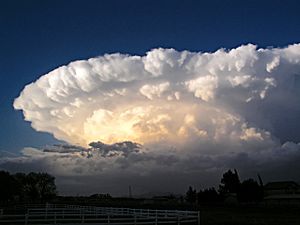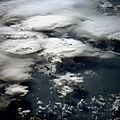Thunderstorm facts for kids

Thunderstorms are powerful weather systems. They bring strong winds, heavy rain, bright lightning, and loud thunder. For a thunderstorm to form, two things are needed. The air near the ground must be warm and wet. Also, the air higher up must be unstable. Every second, about 100 lightning bolts hit Earth. At any moment, around 1,800 thunderstorms are happening worldwide.
Thunderstorms are not common in winter. This is because of the cold weather. When they do happen in winter, it is called thundersnow. Thundersnow often occurs during blizzards.
Contents
How Thunderstorms Form and Grow
You might notice more clouds in the afternoon than in the morning. This happens because the ground warms up during the day. This warm ground causes winds to blow upwards. These upward winds are called updrafts. As the air rises, the water vapor in it turns into tiny water droplets. These droplets then form a cumulus cloud.
The height where clouds form depends on how warm and humid the air is. Sometimes, air can rise thousands of feet before a small cumulus cloud appears. These small, puffy clouds don't change much unless more moisture is added. More moisture helps the updraft get stronger. It also adds heat, making the cloud warmer inside. This causes the cloud to rise even faster.
The moisture makes the cumulus cloud grow upwards like a mushroom. It becomes a very tall cumulus cloud. The winds inside this cloud are extremely strong. Thunder and lightning start when the cloud reaches about 25,000 feet high. By this point, the inside of the cloud is cold enough to turn water drops into ice crystals. A cumulus cloud stops growing when it hits the warm stratosphere. Some thunderstorms can grow twice as high as Mount Everest!
What Happens Inside a Thunderstorm Cloud
Strong winds high up in the stratosphere flatten the top of the cloud. This makes the cloud look like a giant mushroom or an anvil. The ice crystals in the anvil-shaped top give it a fuzzy look. As a thunderstorm grows, water drops and ice crystals inside the cloud bump into each other. They mix and get bigger. The bottom of the cloud turns dark as it fills with water ready to fall.
When the drops become too heavy for the winds to hold them up, they fall as rain or hail. Even as they fall, the water drops grow by collecting smaller drops. This creates large raindrops. Hail also grows bigger inside the cloud. Most single thunderstorms run out of energy in about 30 to 50 minutes. However, very strong storms called supercells can last for hours. They eventually fade away when their energy is used up.
Lightning and Thunder
Thunderstorms are full of electricity. That's why they are also called electrical storms. Lightning is a huge electrical spark. It happens between two areas with opposite electrical charges.
When lightning strikes, it releases a lot of energy. This energy heats the air around it very quickly. The air then expands fast, creating sound waves. Thunder is the sound we hear from this rapid expansion of air along the lightning path. Thunder is always heard after lightning is seen. This is because light travels much faster than sound.
Dangerous Thunderstorms
Only about 10% of thunderstorms are considered dangerous. These dangerous storms can cause very strong winds, over 58 miles per hour. They can also bring large hail, about 1 inch wide. Dangerous thunderstorms can also lead to sudden floods and tornadoes.
Hailstorms can damage crops and cars. They can also break windows. Sudden floods caused by heavy rains are a major reason for weather-related deaths. Lightning, which happens in all thunderstorms, causes thousands of forest fires each year. It also injures or kills hundreds of people annually.
Regular thunderstorms start when warm, moist air near the ground rises. This creates an updraft. A dangerous thunderstorm needs a very strong updraft and a strong downdraft (a wind that goes downward). A strong updraft forms when the ground is very hot, the air is very moist, and the air above is very cold. The stronger the updraft, the more powerful the thunderstorm becomes.
Flash Floods
Flash floods happen when slow-moving thunderstorms drop a lot of rain in a small area. It rains so hard that the ground cannot soak up the water fast enough. The water then rushes down hills into streams and rivers. These waterways cannot hold all the water, so they quickly overflow. The most dangerous flash floods cause water levels to rise quickly in streams, dry riverbeds, or canyons.
Flash floods can cause terrible mudslides. They move very quickly. They can roll large rocks, pull out trees, and destroy buildings and bridges. Flash floods can also happen if two or more thunderstorms hit the same spot one after another. They can also occur when a dam breaks or ice melts quickly. Heavy rain on rapidly melting snow can also cause flash floods.
Benefits of Thunderstorms
Even though thunderstorms can be dangerous, they are very helpful. They provide a lot of water for many parts of the world during summer. Plants get much-needed rain to grow. Without thunderstorms, many areas would become dry. Fish would die, crops would fail, and animals would suffer.
Thunderstorms also act like natural air conditioners. Hot air from the ground rises into the upper atmosphere. There, the heat is released into space. Clouds provide shade, and rain can cool down a hot day. Without thunderstorms, Earth could be about 20 degrees Fahrenheit warmer. In summer, dust, haze, and other pollution gather in the lower atmosphere. When the air rises in clouds or thunderstorms, it spreads this pollution higher up. Rain from thunderstorms also washes many of these pollutants out of the air.
Lightning in thunderstorms helps keep the electrical balance between Earth and the atmosphere. Lightning is also like a natural fertilizer. As it flashes through the sky, it changes nitrogen gas in the air into nitrogen compounds. These compounds fall to the ground and enrich the soil. Nitrogen is a key ingredient in fertilizer. About ten percent of the nitrogen fertilizer needed for farming is made by lightning.
So, while thunderstorms are powerful and can be dangerous, they are also very helpful. They bring summer rain, cool the Earth, and clean the air. Lightning balances Earth's electricity and helps fertilize the soil. And after a thunderstorm, you might even see a beautiful rainbow!
Staying Safe During a Storm
Here are some tips to stay safe during a thunderstorm:
- If lightning is nearby, find shelter in a house or car. A low spot under small trees can also work, but avoid sheds. Inside a house, do not use the telephone or any electrical devices. Do not take a bath or shower.
- Stay away from water because it conducts electricity.
- Do not stand on a hilltop. Try not to be the tallest object around.
- Do not seek shelter under a single, tall tree.
- Stay away from metal objects like pipes, fences, and wire clotheslines.
- If your hair stands on end while outside, immediately drop to the ground. Curl up into a ball-like shape.
- If there is a flash flood, stay out of low areas. Do not drive cars through water flowing over a road or bridge. It might look shallow, but fast-moving water can wash a car away. It only takes two feet of water to float most cars. Also, the road under the water might be washed out, leaving a deep hole. A flash flood can easily flip a car and trap people inside. If your car stops in floodwaters, get out quickly and run to higher ground. Nearly half the people who die in flash floods in the United States die inside automobiles.
Thunderstorms in Stories and Beliefs
Thunderstorms greatly influenced many ancient civilizations. The Greeks believed they were battles fought by Zeus. They thought Zeus threw lightning bolts made by Hephaestus. Some American Indian tribes linked thunderstorms to the Thunderbird. They believed it was a servant of the Great Spirit. The Norse thought thunderstorms happened when Thor fought giants called Jötnar. The thunder and lightning were the sounds of his hammer, Mjölnir, striking. In Hinduism, Indra is known as the god of rain and thunderstorms. Christian beliefs also accept that fierce storms are God's work. These ideas were common even up to the 1700s.
A famous story tells how Martin Luther was walking when a thunderstorm began. He prayed to God to be saved and promised to become a monk if he survived.
Thunderstorms Beyond Earth
Scientists have found evidence of thunderstorms on Jupiter. They see flashes of lightning there. These storms are linked to clouds where water can be both liquid and ice. This suggests they form in a similar way to Earth's storms. Water is a special molecule that can carry an electrical charge. This allows it to create the charge separation needed for lightning. Jupiter's electrical discharges can be a thousand times stronger than lightning on Earth. Its water clouds can form thunderstorms driven by heat rising from inside the planet. The clouds of Venus might also produce lightning. Some observations suggest that lightning on Venus happens at least half as often as on Earth.
Images for kids
-
A single-cell thunderstorm over Wagga Wagga.
-
A group of thunderstorms over Brazil photographed by the Space Shuttle Challenger.
-
MCC moving through New England: August 2, 2006 0600 UTC
-
In June 2007, the town of Elie, Manitoba was struck by an F5 tornado.
-
Formation of numerous waterspouts in the Great Lakes region. (North America)
-
Trees uprooted or displaced by the force of a downburst wind in northwest Monroe County, Wisconsin.
See also
 In Spanish: Tormenta eléctrica para niños
In Spanish: Tormenta eléctrica para niños
















